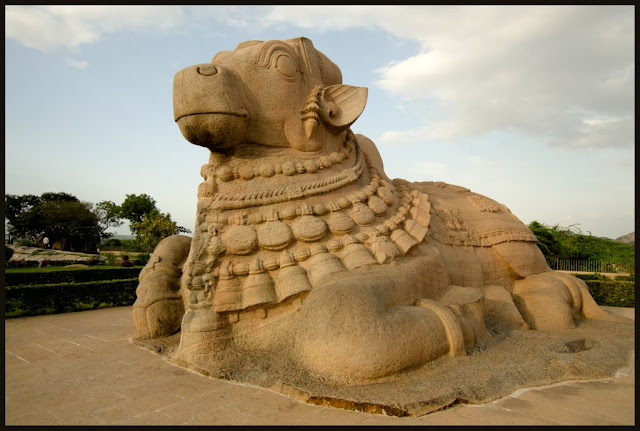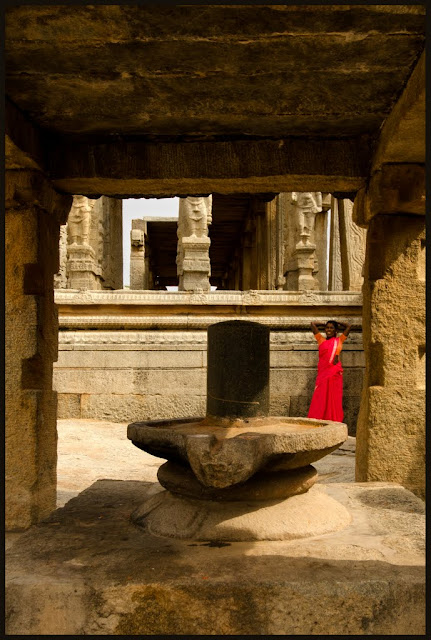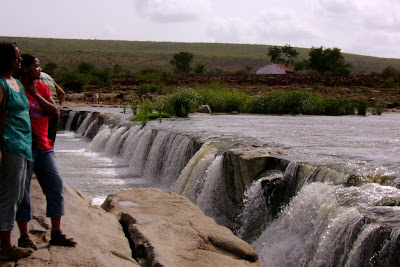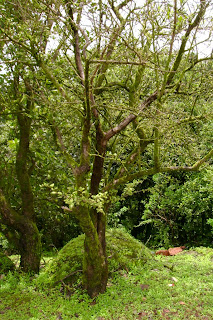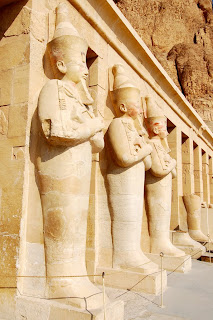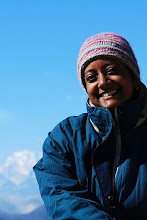Me:
I’m off to Lepakshi tomorrow morning, dad.
Dad:
Where’s that? What does it have?
Me:
It’s in Andhra Pradesh but very close to Bangalore. It’s a temple town - there’s
a Shiva temple and a huge Nandi statue.
Dad:
Hah!
The
tone of the “hah” said it all - incredulous. Probably brought back memories of
when I’d fought with him to not go to temples. An acquaintance used the same
tone when she bumped into me at the temple:”what are YOU doing here?” I too had
asked myself this question before I left Bangalore - will I really enjoy a
temple visit?
Luckily,
I have parents who never forced me to be ritualistic or pious; they let me be.
On the rare occasion that they did force me to go on a ‘family pilgrimage’, I
was thoroughly annoyed by all the din, people paying to get ‘special darshans’ & ‘special blessings’ and
the expectation to wear my piety on my sleeve or what I call PDP: public
display of piety. “Fold your hands” mom would say. “Smear the chandan and the kumkum and the vibhuti” grandma would say. “No jeans” everybody would say. “Prostrate…no, no, not like
that; do it like this!” “Wear flowers in your hair.” “You are not looking
devoted enough.” “When they open the sanctum door, you should crane your neck
for the darshan; don’t stand there
looking uninterested”. “When they ring the bells, call out to the lord….louder!” “Have tears in your eyes at the idol’s sight.” “Elbow everybody and get your prasad.” “You don’t remember your gotra??? How
can you get his blessings?”
At places of worship, I always struggled to find quiet corners which could let me sit and enjoy some tranquility, and appreciate the beauty of the architecture. I decided
that it was time I cast aside my self-imposed ban and went back to
temples sans restrictions, to see if I could enjoy all the things I admire
-architecture, paintings, tales & lore, the finesse of the
sculptures and people-watching. A friend had suggested Lepakshi; I think I
couldn't have chosen better.
When Sita was abducted by Ravana, the mythical bird Jatayu is said to have fought Ravana right here, over the ground where the temple is built. Ravana cut off its wing and Jatayu lay here, injured.
When Rama found Jatayu, he said “le,
pakshi” (rise, bird) and the bird rose. Hence the name Lepakshi.

To
understand the history and lore of the temple, I hired a guide who explained
everything, beginning with how the temple actually has 7 layers in its design.
The outer layers of the temple complex are apparently now occupied by people
who have set up shops and houses within the colonnaded pavilions. So, houses of
the poor may have up to 10 columns within them while larger houses supposedly
have up to 200 columns! The temple complex currently occupies about 5 acres of
land. A tortoise-shaped rocky hill is where it all began. It is presumed that
a small shrine installed by sage Agastya already existed here when Achyutaraya
(Achyuta Devaraya), the ruler of the Vijaynagara Empire, came upon it in the 16th
Century. This temple was planned and begun by Virupanna, Achyutaraya’s trusted
treasurer, in 1530 AD. He was assisted by his brother Veeranna. It was built in
the Vijayanagara style of architecture, using brown and grey granite. The
temple construction continued till 1542 AD, when a few enemies of Virupanna
complained to the king that the treasury funds were being embezzled by him.

The
temple is today known as the Veerabhadraswamy temple: Veerabhadra being the
wrathful form of Shiva. This is said to be the spot Shiva threw a clump of his
hair on, when he found that his beloved Dakshayani had died, insulted by her
father. She was re-born as Parvati and married Shiva once more. Besides
Veerabhadra, there are shrines dedicated to Lord Shiva and Vishnu too. There is
a pavilion connecting all the three shrines and a hall for ritual dance (Natya mantapa) as you enter the temple.
Wandering
in the Natya mantapa, I tore my eyes
away from the life-size sculptures to look up, only to have lovely paintings
vie for my attention. These paintings have been coloured using vegetable and
natural dyes. For the next hour, I was the fool in the temple, walking with my
head turned upwards, bumping into columns and people, all while muttering to
myself about how beautiful these paintings were. But, people were strangely
indulgent of me. This is also when I almost trampled my guide, who was seated
near a column for some rest. Had he not said “That’s Rambha” in time, I would
have stepped over him. Instead, I hired him to guide me around the temple.
I turned my aching
neck downwards to focus on the statue he was pointing to - Rambha, the apsara, the celestial nymph, dancing as
the gods watched. Rambha mimicked her three-legged
dance teacher, also sculpted there, and both statues were in the exact same
pose. The gods arrived to watch the spectacle and play an instrument or two. I
looked back upwards to admire more paintings - Parvati grooming herself and
peering into a mirror; Baby Krishna, with his eye following you all around;
Ravana with his Shivalinga, and many
more such mythological tales. Looking down once more, I was stunned to see the ‘hanging column’, a column which does
not touch the floor. Apparently, the British were equally stunned and tried to
find out how the column stood. In doing so, they moved it slightly. That led to
many other columns and beams around re-aligning themselves. Scared that the
temple would collapse, they let it be and there were no further investigations.
It was obvious to them that this was a very crucial column, probably one of the
main supports.
When
you go inside the main sanctum and circumambulate, definitely walk into the
smaller chambers that you see and turn your eyes to the ceiling. It has
beautiful paintings - all worn out, though. The main sanctum itself has a large,
splendidly-painted ceiling which is unfortunately faded and sooty. But, I am
happy that it has been left as is and not been subjected to shoddy re-painting
under the guise of ‘restoration’. At least I can spot glimpses of the original
craftsmanship, which has no parity.
The
afternoon sun did not dampen my enthusiasm to walk around the complex. Luckily,
the monsoons made it a warm but bearably hot day. Visitors seeking shade rested
in the cool and shaded dance hall, oblivious to the heat outside. I walked on
to find a large footprint in my path, filled with water and having turned a
little green from the algae. I was told that this is Seeta’s footprint and a
perennial source of water, considered holy. As if on cue, devotees appeared and
cupped some water with their hands, drinking it, and then sprinkling a little over
their heads. A couple of steps ahead, there were curious circles scooped into
the rock. “A colour palette?” I asked. My guide nodded negatively and said that
it was a thali (a plate with multiple
bowls), where workmen sat for lunch, and food was served in the various
‘bowls’. “Wasn’t it too large to be a thali?”
“Not really,” said my guide “considering the fact that humans then were gigantic, almost 7 to 8 feet tall.” I wondered whether to believe that
but then, decided to; don’t things like these make for the fun, fantasy-filled
stories I love?
I
had more such stories in store for me. As we approached the Nagalinga where a Shivalinga sits shielded by a coiled, seven-headed snake, my guide
told me how it was built. During lunch break, a group of brothers waited
outside the kitchen at this spot, as their mother hurried to cook their meal.
Not wanting to waste their time waiting, they built this in the 30 minutes that
it took their mother to prepare the food. When she came out to call them, she
was surprised to see the Nagalinga, and
the power of surprise from her vision (also called nazar) was so strong that the sculpture cracked in two places.
Lepakshi,
it seems, was quite the cradle of arts and crafts in the region. Various
repetitive motifs in the paintings were pointed out to me; they are reproduced
on fabrics till today (bed-covers, mostly) and known as Lepakshi prints. In the
Lata mantapa or the hall of creepers,
each of the 42 columns is embellished with a unique creeper design on every
face. These are popular as ‘border’ designs, apparently a favourite with
Kancheepuram saree makers even today.
As
I stood in the Kalyana mantapa, I
marvelled at what my guide called ‘special effects’: two monkeys that would also
seem like four. And, a three-headed cow, which, depending on the head you
focused on, looked like it was standing, grazing or licking itself. My guide then
pointed out to two reddish smear marks on a stone wall nearby. He went on to
tell me that this was the blood from Virupanna’s eyes, when he threw them here.
“And why would he do such a thing?” I asked, aghast. Apparently, when the king
received the embezzlement complaint, he ordered that Virupanna’s eyes be gouged
out and he be blinded, as was the customary punishment those days. When the
loyal Virupanna heard this, he decided to carry out the task himself. And, the Kalyana mantapa remained unfinished. It
was the last part to be built in the temple complex.
I
gazed at the ornate columns of this Kalyana
Mantapa, built at the spot where Shiva and Parvati were said to have
married, many yugas ago. The sculptures
of all the guests, the bride and the groom are exquisite. Had it been completed,
it might have had a roof; maybe, with vibrant paintings as well. Or domes,
maybe? One can only speculate. Today, I had a brilliant blue sky with dramatic
clouds for a roof, and that worked fine as well.
I
stopped at the Nandi on my way out of Lepakshi. It is India’s largest Nandi
carved out of monolithic granite. The second largest is at Tanjore’s
Brihadeeshwara temple and the third largest is at Chamundi Hills, in Mysore.
The Nandi is in the middle of a garden which is a favourite with locals as
well. There’s never a free moment and quite a challenge to photograph the bull
without people or with the subjects you want. It’s a beautiful piece of work -
with lovely doe-eyes, a benevolent countenance and a hint of a smile.
Admiration-worthy are the neck and ear ornaments and the saddle on the back. I
left Lepakshi just as the sun hinted at setting, happy with my day.

















